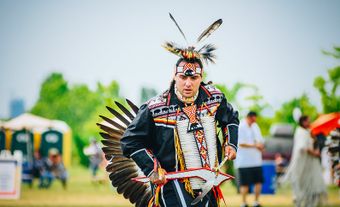Canada has about 350,000 official place names. While many of these names honour people, a great many others reference physical or human geography. This list showcases the latter, highlighting names that point to the natural features of a place — take Montreal, for example — or how people interact with the land, be it through travel or settlement (as in Portage la Prairie, Manitoba). And, as with “Canada” itself, many of these names stem from an Indigenous word, or are themselves in an Indigenous language, such as Ulukhaktok, Northwest Territories (see also Largest Cities in Canada With an Indigenous Name).
Union Road, Prince Edward Island
In the 1760s, the land on Prince Edward Island was divided through a process called “surveying.” It was split into large parishes, each of which had multiple townships, called “lots.”
The road between lots 33 and 34 was named “Union Road.” The origin of the name is uncertain, but some credit the fact that it is a route between Charlottetown and the island’s north shore. When a small settlement on the road received a post office in 1875, it chose to name the community Union Road. The Municipality of Union Road was created in 1977.
Middleton, Nova Scotia
A settlement called Wilmot Corner was located in the middle of Wilmot Township, in Nova Scotia’s Annapolis County. It was also in the middle of Annapolis Royal and Kentville. In 1854, residents decided to rename their community Middleton.
While there’s only one city with the name, Nova Scotia is fond of the moniker. Small communities in other counties have also used the name.
Tide Head, New Brunswick
Tides are the rise and fall of sea levels. This ebb and flow can often be noticed many kilometres away from the ocean, on rivers. Wherever the water stops being affected is known as the “head of tide.” On the Restigouche River, this spot became the location of a village, known as Head of Tide, and later Tide Head.
Similarly, a Wolastoqiyik village on the Saint John River was called Aucpaque, meaning “tide head.”
Cow Head, Newfoundland

When a sedimentary rock contains pointed fragments of other rock or minerals, it’s called a “breccia.” In the north end of Gros Morne National Park, you can find breccia formed 70 million years ago. According to local fishermen, one of these weathered boulders looked something like a cow’s head. While it’s since been washed away, the fishermen’s name stuck.
Montreal, Quebec
In 1535, on his second voyage to Canada, Jacques Cartier was searching for a trade route to Asia. He paused at Hochelaga, an Iroquoian village on the St. Lawrence River. He named a small, nearby mountain, “Mont Royal.” In 1642, the French colonial village of Ville-Marie was founded near the same mountain. Its name eventually became Montreal.
Brantford, Ontario
After fighting alongside the British in the American Revolution, Joseph Brant (Thayendanegea) led the Mohawk Loyalists and others to land on the Grand River. (See Haldimand Proclamation.)
If you want to cross a river on foot or by horse, you need to find a shallow spot. The location where you wade across is called a “ford.” One regularly used location became known as “Brant’s Ford.”
Portage la Prairie, Manitoba
The Assiniboine River flows through some of Manitoba’s key cities, including Brandon, Portage la Prairie, and Winnipeg. One thing it doesn’t do, though, is connect to Lake Manitoba.
To get between them, you need to carry your canoe and goods from one to the other. The French Voyageurs called this a prairie portage, or portage de la prairie.
Moose Jaw, Saskatchewan

The Cree name for the Moose Jaw River is moscâstanisîpiy, or “warm place by the river.” No one knows exactly how the English name came to be, but there are two main theories.
The first two syllables of the Cree word, moscâ, sound similar to “moose jaw.” It was also noted by early settlers that the shape of the river as it flowed into and out of the town resembled a moose jaw, and that the hills in the area, when standing by the mouth of the river, were similarly shaped.
Spruce Grove, Alberta
Homesteader John Allan McPherson and his friend Alexander McNabb settled west of Edmonton. The area had ample spruce, including a large grove near McPherson’s house. In 1894, McNabb opened a post office, naming it Spruce Grove. Ironically, by that point, most of the groves had been cut down for farming.
White Rock, British Columbia

As the glaciers receded at the end of the last Ice Age, they scraped and shaped the land. In the retreat, a massive 441-tonne chunk of granite was dropped on the shore of Semiahmoo Bay. Seabirds loved to hang out on it, their poop blanketing the surface. The avian incontinence was so white that sailors would use it as a landmark.
The City now paints the rock white, to keep up appearances. The rock appears on the city flag and on the coat of arms.
Ulukhaktok, Northwest Territories
The Inuit traditionally used a crescent-shaped cutting tool called an ulu to prepare food or skins for clothing. In certain parts of the Inuinnait’s traditional territory, there are large deposits of copper, which they used for making various tools.
One deposit is found on a large bluff on Victoria Island, named Ulukhaktok. In the Inuinnaqtun dialect of Inuktitut, this means “the place where ulu parts are found.” In 2006, the hamlet of Holman returned to this traditional name.
Whitehorse, Yukon
During the Klondike gold rush, thousands of horses were taken north through the harsh terrain. Roughly 3,000 horses died along White Pass, a trail between British Columbia and Alaska. One spot in Alaska is known as “Dead Horse Gulch.”
But these frostbitten casualties aren’t the namesake of Yukon’s capital city. Instead, to prospectors, the Yukon River’s wild waters at Miles Canyon resembled the manes of horses. From 1900 to 1957, the community had a two-word name, White Horse.
Grise Fiord/Aujuittuq, Nunavut

Both Inuktitut and Norwegian names reference the geography of Canada’s northernmost civilian community.
Norwegian navigator Otto Sverdrup mapped parts of Ellesmere Island’s coast from 1899 to 1902. Hearing a walrus, he was reminded of the sound of pigs grunting. He named a nearby fjord (a deep inlet between two high cliffs) Grise Fiord, meaning Pig Fjord.
When the community was created in 1953, residents dubbed it Aujuittuq, meaning “place that never thaws.” Even during the sunlight of the summer, 24 hours a day, the fjord’s water never fully thaws. (See also Inuit High Arctic Relocations in Canada.)

 Share on Facebook
Share on Facebook Share on X
Share on X Share by Email
Share by Email Share on Google Classroom
Share on Google Classroom



